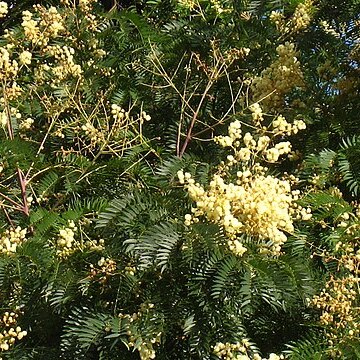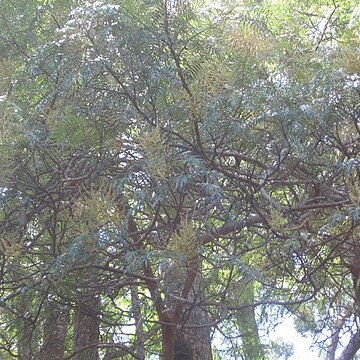Unarmed tree, 15-25 m. Branchlets terete, finely puberulous. Leaves bipinnate, rachis and pinnae very sparsely puberulous; rachis 11-17 cm, petiole 8 cm, gland at about the middle of the petiole, el-lip tic in outline, with a very narrow orifice, c. 4 mm, distal part of rachis glandular; pinnae 2-4 pairs, 8-14 cm, leaflets opposite, subsessile, 8-14 pairs per pinnae, rigidly chartaceous, ovate-oblong, lanceolate-falcate or ovate-lanceolate, bent forwards, acuminate-caudate, acute, 2.9-4.2 by 0.4-0.9 cm, both surfaces scarcely appressed puberulous. Inflorescences consisting of pedunculate glomerules, c. 0.4-0.5 cm diam., aggregated in axillary racemes or terminal panicles. Pod oblong, 10-15 by 1.25 cm, funicle short.
Unarmed tree. Leaves bipinnate, large, 30-40 cm long; pinnae 3-5 pairs; leaflets 8-15 pairs per pinna, mostly 2-6 x 0.4-1 cm, lanceolate to linear-lanceolate, often somewhat falcate, usually finely pubescent at least on the lower surface. Flowers pale yellow, in round heads, arranged in axillary racemes or panicles. Pods ±9-15 x 0.9-1.3 cm, linear-oblong, straight or curved, the margins irregularly constricted between the seeds, compressed, dehiscing along both margins.
Tree, 9-20 m high, trunk with side limbs when old, young branchlets golden-hairy. Leaves bipinnate; upper surface dark green, glossy, 300-400 mm long; pinnae 3-5 pairs, each with 8-15 leaflet pairs. Flowers globular heads in axillary racemes, pale yellow. Flowering time Oct.-Dec. Pod brown, 90-150 x 9-13 mm, linear-oblong, straight or slightly curved, fine gold-coloured hairs, margins irregularly constricted between seeds, dehiscent.
Unarmed, evergreen tree to 20 m. Leaves bipinnate, dark green, glossy above. Flowers in globose heads, pale yellow. Pods brown, finely golden-hairy.
Leaves 2-pinnate, large; pinnae 3-5 pairs; leaflets mostly 2.5-5 x 0.4-1 cm., lanceolate to linear-lanceolate, appressed-puberulous.
Flowers pale-yellow, in heads arranged in axillary racemes or panicles.
Tree 6-18 m. high, unarmed; young branchlets puberulous or pubescent.


